There’s having a meal plan, and then there’s what I do. Most days I intake (what I call eating and drinking) six ounces of chicken breast or salmon fillet four times a day. I eat four cups of vegetables, including a cup of asparagus before bed. I eat hardly any salt, or sugar, or flavor, for that matter.
What I eat is Groundhog Day for my taste buds, but it helps me stay photo-shoot-ready. For most people, time is money. For me, time is muscle.
But I’ve noticed that more of the guys in my gym have started cooking—or “meal prepping.” The more I talk to them, as well as to Paul Kita, the food and nutrition editor at Men’s Health, the more I wonder if I could gain an edge by learning to cook.
Plus, I’m in my 30s now and paying off a mortgage, and cooking at home is cheaper. And maybe I’ll spend more time in the kitchen with my wife, Jen. But until this story, I’d “cooked” exactly two dishes in my life—and one was instant ramen. Turns out I had a lot to learn.
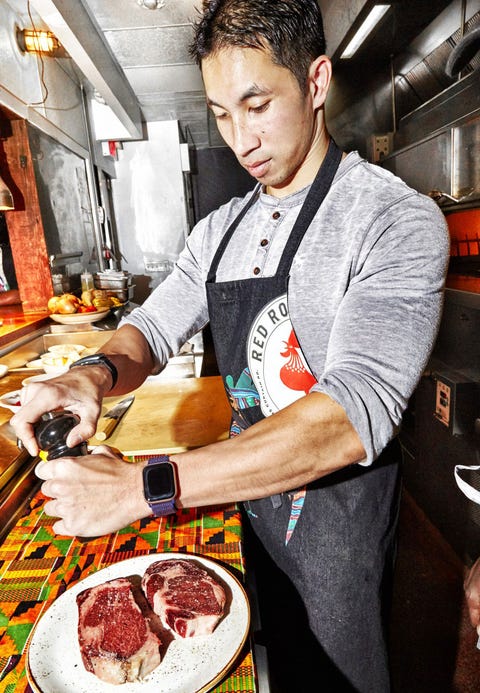
Lesson 1: Sharpen Basic Knife Skills
Kita convinced me that good food and food that’s good for you aren’t mutually exclusive—and that I could cook it in less time than it would take me to rip through a leg session.
He connected me to chef Marcus Samuelsson at Red Rooster in Harlem for a culinary crash course. Samuelsson’s a workout guy, so he might understand my idiosyncrasies. Like how I’m bringing a protein shake to our first lesson.
Samuelsson is a big deal with a background in bold flavors. He was born in Ethiopia, grew up in Sweden, trained in kitchens throughout Europe, and now runs several of his own restaurants. Come mid-May, he’ll be presiding over Harlem EatUp!, a food festival he’s headed for the past four years; this year, he’s partnered with WW to develop healthful menu options for the event.
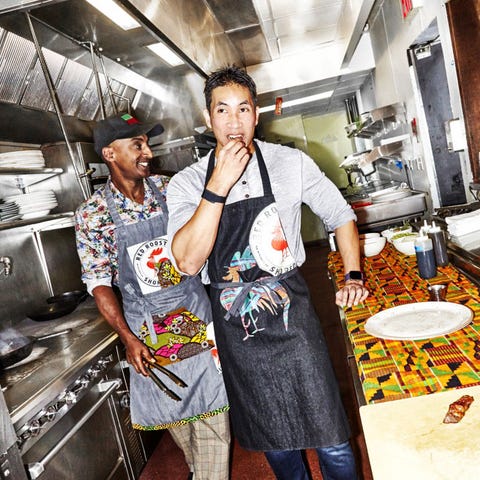
But his stardom isn’t why I’m sweating as I enter his kitchen. It’s hot in here and feels claustrophobic. I resist the urge to flee, because Samuelsson promises that he’ll teach me to make three practical dishes. I wonder, though, whether he realizes who he’s working with.
“Let’s start with dicing an onion,” Samuelsson says. He removes the skin from one, cuts it in half, and then makes horizontal slices through it from end to stem. Next, he slices it vertically across the horizontal slices. Perfect cubes of onion form, as if by magic.
My turn. I put my hand on the other onion half. Samuelsson stops me. He wants my fingers curled, knuckles on the onion. That way, I’d only sheer some skin off my knuckles if I mishandled the knife. I start slicing jagged onion pieces. Samuelsson laughs and hands me scallions. “These are easier to practice on,” he says. Like bench-press form, knife work is a skill that requires repetition.
Lesson 2: Include All the Flavors
Next, Samuelsson wants me to cut three slits in the salmon skin so it will sear flat and turn crispy. I watch as he puts the fish in the pan, skin side down. “You’re eight minutes away from your meal,” he says. Now he has my attention. When the salmon’s ready, we move it to a plate, glaze it with a miso sauce, and then wait five minutes.
I’m ready to eat, but Samuelsson says, “You want it to rest. It’ll cook the fish through and let the flavor settle.” I count down, then dig in—amazing. He reveals that the secret is a blend of flavors that gives my mouth all it could want. An ideal dish has flavors from five categories: salty, sweet, bitter, sour, and heat. “Try to include all of those flavors in all your cooking,” he says.
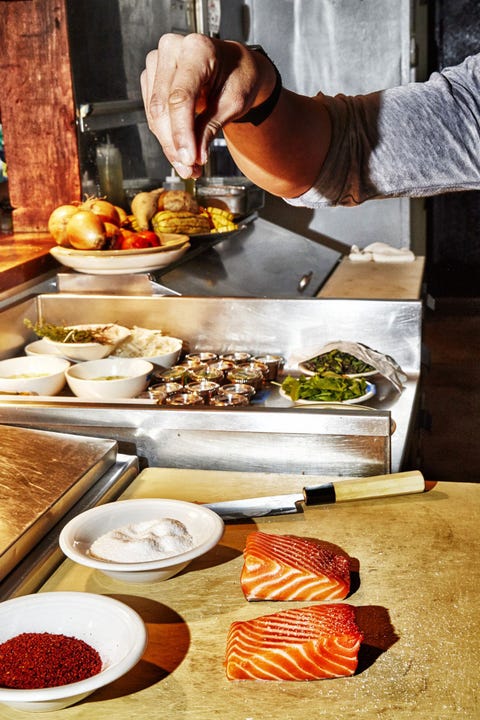
AMY LOMBARD
It clicks: This is why I can barely eat just a few cheat-day Oreos before getting sick of them. They have one flavor: sweet. Complex flavors follow in the second dish. It’s steak with apples (sweet), napa cabbage (bitter), and soy sauce (salty).
I step in just once, when Samuelsson asks me to sprinkle the steak with pepper. And naturally, I do that incorrectly too. “Sprinkle from higher up,” he says, moving my hand a foot over the beef so that I more evenly season the meat.
Samuelsson wraps up by teaching me how to braise chicken. He starts by pan-searing chicken pieces, then covers them in a tomato-based sauce and slides it all in the oven. It’s the most complex chicken dish I’ve ever tasted.
Lesson 3: Flex Your Creative Muscles
It’s a week later, and after an hour of grocery-store hell (who knew thyme could be so hard to find? also: what is thyme?), I’m in my kitchen, trying to cut a hunk of salmon in two with a dull knife.
It’s not cutting. I start pulling it apart with my hands; that doesn’t work, either. Later Kita tells me to use kitchen scissors. I glaze the salmon once it’s ready, then take a bite. Boo.
I buy two more pieces of salmon the following Sunday and try again. It’s not bad either time, but I resolve to figure out what I’m doing wrong in my follow-up with Samuelsson.
Except that doesn’t happen. Samuelsson alters both the salmon and steak recipes on the fly. I’m initially confused, but then I understand. The recipe is a starting point, a guide.
Which means I can make my own improvements. Back home, instead of making Samuelsson’s braised-chicken recipe with a whole chicken, I use three chicken breasts. I like garlic, so I add a few extra cloves, and I skip celery in favor of pre-bedtime asparagus.
I pull it out of the oven, slice off some chicken, and try my version. Solid. Then I combine small pieces of chicken with brown rice and some gravy (is that what you call it?) and relish my homemade meal like no protein shake before.
WHAT I LEARNED TO COOK
Salmon with Miso Sauce
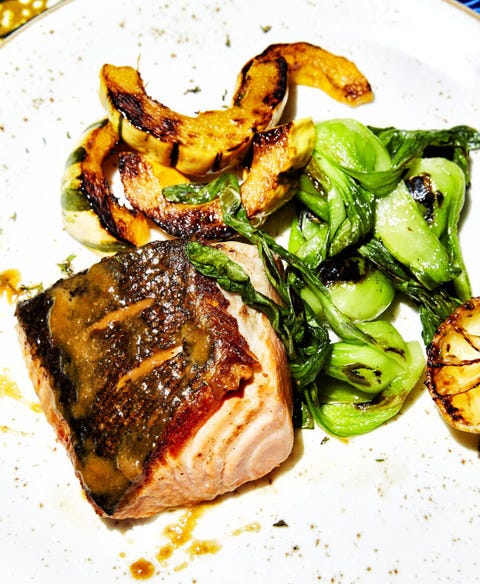
AMY LOMBARD
What You’ll Need:
How to Make It:
1. In a small bowl, mix together the miso paste, soy sauce, honey, olive oil, and garlic. Set aside.
2. Heat a large nonstick pan over medium high. Add the canola oil. Season the salmon on both sides with salt.
3. When the oil begins sending up wisps of smoke, add the salmon, skin side down, placing the fillet away from you. Reduce the heat to medium and cook until the skin crisps, about 5 minutes. Flip the salmon and cook until medium rare, about 2 minutes.
4. Transfer the salmon to a plate and pour the sauce over it, to taste. Wait 5 minutes, then serve with a starch and greens. Feeds 1
Strip Steak with Apple Cabbage Kale Salad
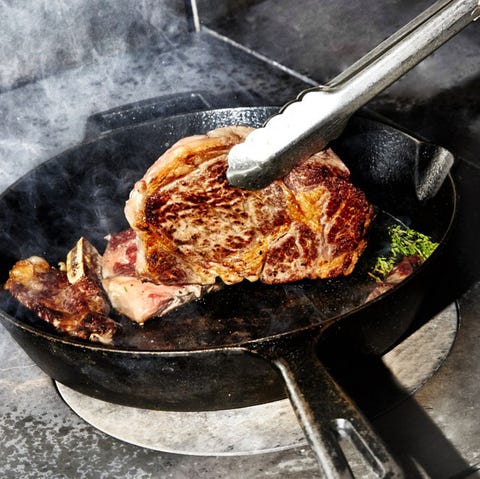
AMY LOMBARD
What You’ll Need:
How to Make It:
1. Remove the steak from the fridge for at least 30 minutes before cooking.
2. Preheat your oven to 350°F. Season the steak on both sides with salt. Heat a large, oven-safe pan over medium high. Add the canola oil. When the oil begins sending up wisps of smoke, add the steak, placing the fillet away from you. Cook until well seared, about 2 minutes on each side.
3. Add the shallots, garlic, and thyme, and transfer the pan to the oven. Cook until a meat thermometer inserted into the thickest part of the steak registers 120°F, 4 to 6 minutes. Carefully remove the pan from the oven, place on a heat-proof surface, and transfer the steak to a cutting board. Remove the garlic and thyme and discard.
4. Return the pan to medium-low heat, and add the cabbage, orange juice, jalapeno, soy sauce, olive oil, baby kale, and half of the apple. Stir well until slightly wilted, about 4 minutes.
5. To serve, transfer the cabbage mixture to a plate. Slice the steak into ¼-inch-thick pieces and arrange atop the cabbage. Top with the remaining apple. Feeds 1
Braised Whole Chicken in Tomato Sauce
What You’ll Need:
How to Make It:
1. Preheat your oven to 375°F. Heat a large, high-walled pan or Dutch oven over medium-high. When the oil begins sending up wisps of smoke, add the chicken and reduce the heat to medium.
2. Cook the chicken until well browned on all sides, 6 to 8 minutes total. Transfer the chicken to a plate. Add the celery, carrot, onion, garlic, and thyme. Cook, stirring frequently, until slightly browned, about 2 minutes.
3. Add the tomatoes, stock, and a big pinch each of salt and pepper. Return the chicken to the pan, turning to coat the pieces in the sauce. Carefully transfer the pan to the oven and cook until the chicken is cooked through about 45 minutes.
4. Carefully remove the pan from the oven and place on a heat-proof surface. To serve, transfer the chicken to a plate and spoon some of the sauce over the meat. Serve with rice and leafy greens. Makes 4 servings
Source: Read Full Article